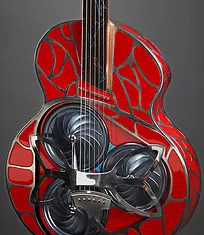Papaléocada

Predestined for the 2010 Montreal Guitar Show, the Papaléocada is a lap steel guitar that emanates a tremendous sound.
The name came about when Alquier’s one-year-old was asked, where’s daddy? Her response in broken, baby french was, “papa lé au cada.” The translation in adult, english speak is, “Papa’s in Canada (for the Montreal Guitar Show).” Hence Papaléocada, which to Alquier sounds Hawaiian. It’s befitting since the style of playing lap steel originated from Hawaii.
The Papaléocada is the second of Alquier’s triptych of concept guitars. The first is Air Mail, which was also a show stopper in the previous Montreal show. Together they are two peas in a pod. The idea was to maintain the same ingredients. It has the sporty red finish, the curly maple and mahogany and turquoise motifs. It includes the discrete design of the head and tuning machines, turned inside out. It also gave Alquier a chance to work with same master craftsmen who supplied custom parts, wisdom and undeniable grit. After all, it’s a concept guitar. It rides on unfiltered dreams of luthier, which floats on generations of knowledge.
The Papaléocada was meant to be as Alquier had purchased the cones and T easel from fellow luthier Mike Lewis five years earlier. Lewis builds superb resonators. Alquier promised he would honor the parts in a unique build.
Alquier’s vision was to create a hybrid wooden and metal tricone. This would be an updated take on the first resonators made, dating back to 1927 by National. It took Alquier eight months to design and manufacture this poetic anomaly of an instrument.
As intricate as the Papaléocada seems, it was more painstaking to build. The result is divine. The visible stainless steel is an exoskeleton that Alquier built with Jean-Michel Adol from at Dupont Guitars. Between this breathable structure is solid, curly maple that Alquier cut up into 115 pieces and varnished in bright, flaming red. The assembly of these pieces is akin to the that of a church’s stained glass, but with less room to work with.
Alquier designed the pickup, while Nicolas Mercadal of Benedetti developed and optimized it. It’s accompanied by a small head amp by Christophe Jégou, altogether producing a phenomenal sound. The amp has a KT66 lamp and is less than 10 inches (25cm).
The mahogany neck is reinforced by carbon. It has a blackwood fingerboard and turquoise inlays with recurring motifs. The tuning machines is custom designed by Rodgers and is steel-plated carbon. The tone bar is also custom made.
The guitar has a removable, carbon capo and a rolling nut which can slide to the 12th fret. This tone is adjustable to one’s desire.
The cones were anodized and the bridge is chrome-plated, thanks to the help of luthier Hervé Tonnard. The guitar looks like it’s dressed in a bow tie. The embedded, steel butterfly atop the strings is a hand rest.
The piezo Benedetti pickup is made for tricone aficionados. There are two independent XLR outputs. There is no potentiometer on this instrument. The knobs are on the amp.
The instrument has a fitted Calton case, with an interior embroidered by fairy hands.
